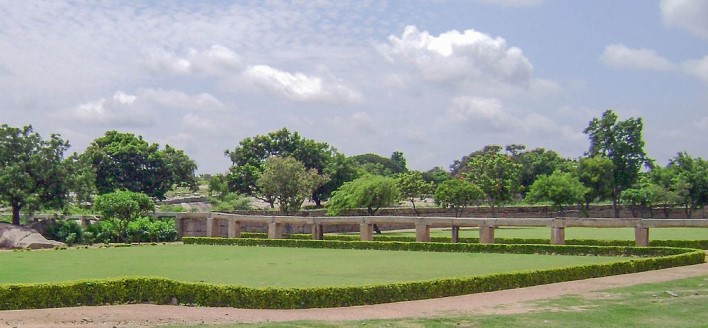Hampi was once a thriving place and formed an important part of the Vijayanagara Empire. In addition to its beautiful monuments and temples, Hampi has an extensive network of aqueducts and canals that spreads across the whole area.
It is a wonder that the rulers of the Vijayanagara Empire had managed to build such an intriguing network of waterways that reached each and every corner of Hampi.
The aqueducts and canals of Hampi are an attraction for tourists and modern architects alike, who marvel at the skilled planning of the waterways in the ancient village.

Quick Facts
- Timing: From dawn to dusk on all days of the week
- Entry Fee: No entry fee
- Photography: Allowed
- Best time to visit: From November to February
History of the Aqueducts and Canals in Hampi
Hampi is a place that existed before the Vijayanagara Empire was founded. Though a few canals existed in Hampi in the era predating the Vijayanagara rule, most of the waterways of Hampi were built by the rulers of the Vijayanagara Empire.
Hampi was an important centre of activity during the period of the Vijayanagara Empire and the rulers contributed to the architectural development of the area in a major way.
The architectural development also included the construction of a planned water network that included large canals. The waterways were planned to fulfil the need for water in Hampi.
The Interesting Network of Aqueducts and Canals in Hampi
Hampi is covered by a network of waterways that are of various sizes. The network of canals connects everything in Hampi, from palaces to temples to water tanks to agricultural lands.
These ancient aqueducts and canals were used to bring water from the Tungabhadra River to the water tanks and baths. There are aqueducts built underground that were used to supply water to the temples in Hampi.
A major branch of the aqueducts supplied water to the Stepped Tank, a large and deep water reservoir situated within the Royal Enclosure.
Fascinating Architecture of Aqueducts and Canals in Hampi
Hampi is dotted with several big and small water tanks spread across the public areas, temples as well as the Royal Enclosure. The well-planned water supply system provided water to all the tanks in Hampi. The remarkable water supply system provides insight into the exceptional city planning carried out by the architects and city planners of the Vijayanagara Empire.
The main stone aqueduct in Hampi runs from east to west in the Royal Enclosure. It is fed by water from the Kamalapura tank. First, the aqueduct provides water to the huge public tank and then proceeds to feed the stepped tank.
The stone aqueduct then branches off to the north and west directions. It then feeds several other big and small tanks situated in the Royal Enclosure, including the Queen’s Bath and the Octagonal Bath.
Hampi has a large number of temples. Water tanks form an integral part of the temple architecture. Most of the temples have a tank constructed near it to carry out ceremonial and functional purposes. All these tanks were connected through the water system.
Major Canals in Hampi
The rulers of the Vijayanagara Empire were responsible for constructing several big and small canals in Hampi. Among them, the major ones are the Raya Canal (King’s canal), Basavanna Canal (Nandi or Bull canal), Turthu Canal (Fast Canal) and the large water tank at Kamalapura.
Present Condition of the Aqueducts and Canals in Hampi
Like most other structures in Hampi, the extensive water supply system has also been damaged to a large extent. However, some parts of the water supply system are still functional. Quite a few canals, especially those passing through the valley areas are still in use.
Most of the major canals built by the Vijayanagara rulers are still used for agricultural purposes. Even now visitors can see the stone waterways built during the ancient period.
One of the largest aqueducts in Hampi is known as Bukka’s aqueduct and is located at the northern bank of the Tungabhadra River at Virupapur Gadde.
The giant aqueduct is in a ruined condition and only traces of the original structure can be seen. It stands as an example of the efforts taken during the ancient days to bring water to elevated areas located in Hampi.
How to reach the Aqueducts and Canals in Hampi
The aqueducts and canals in Hampi is planned networks of waterways that criss-crosses throughout Hampi. The aqueducts can be easily spotted while on a trip to Hampi.
By Air
Hampi is an ancient village with no airport of its own. Ballari (Bellary) is the nearest town to have an airport. Ballary stands at a distance of about 64 km from Hampi. Visitors can reach Ballari by flight and proceed to Hampi by means of local transport.
By Rail
Hampi does not have a railway station. The nearest railway station is located in the city of Hosapete (Hospet). It has the Hospet Junction Railway Station. Hosapete is located at a distance of around 10 km from Hampi. One can take a bus or avail other means of local transport to reach Hampi from Hosapete.
By Road
Hampi is well connected to many towns and cities places by the road network. There are several buses that ply between Hampi and quite a few major towns and cities in Karnataka. Visitors can hire private cars, cabs or other vehicles from major cities like Bengaluru (Bangalore) or Mysuru (Mysore) to reach Hampi.
Also See: